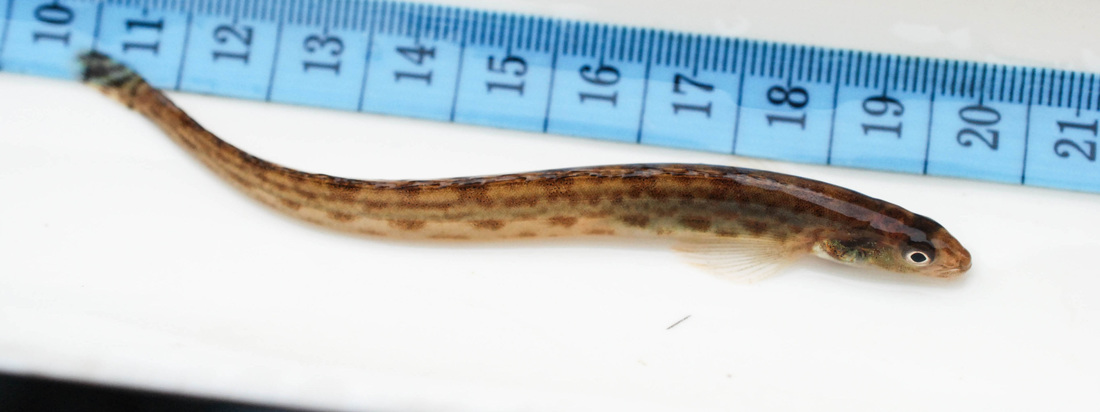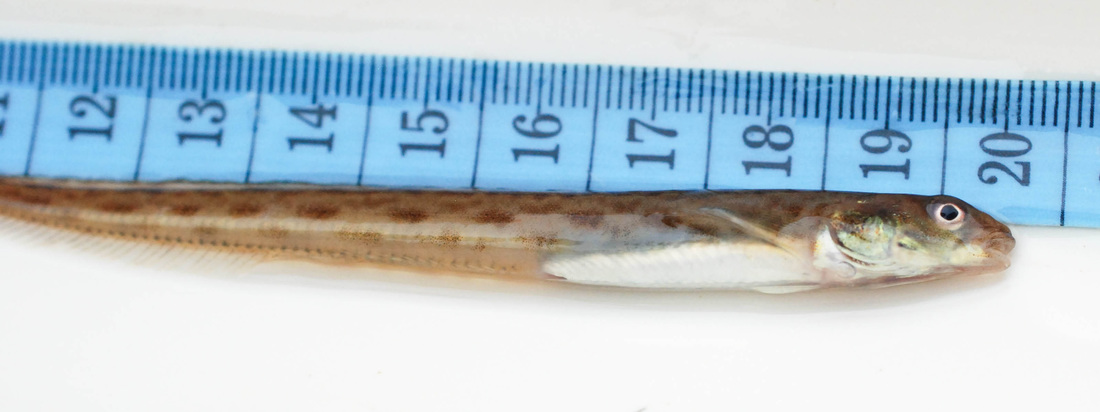Snake prickleback • Lumpenus sagitta
Identification
This prickleback has an elongate body up to 51 cm long. Like other pricklebacks it has long, low dorsal and anal fins and a narrow, oval ended caudal (tail) fin. Its pectoral fins are moderately large and bluntly-pointed. Its body is pale green on the dorsal side, transitioning to cream underneath (ventral side), with the sides of the body bearing dark green to brown horizontal bars from head to tail. The dorsal fin has vertical brown bars and dark dots; similar markings form bands on the caudal fin. Brown streaks or spots run between dorsal fin and the horizontal barring.
Habitat & Range
The snake prickleback is found on muddy or sandy substrates from the intertidal to 425 m deep. It migrates to shallow coastal waters for summer and early fall. Its range extends throughout most of the North Pacific, from the Sea of Japan to the southern Sea of Okhotsk in Russia; in the Bering Sea from St. Lawrence Island to Adak Island; and south to San Francisco.
Intriguing Info
Snake pricklebacks are often found lying arrow straight on the benthos because their vertebral arrangement doesn’t allow them to curl, unlike other pricklebacks.
iNaturalist
https://www.inaturalist.org/taxa/224164-Lumpenus-sagitta
This prickleback has an elongate body up to 51 cm long. Like other pricklebacks it has long, low dorsal and anal fins and a narrow, oval ended caudal (tail) fin. Its pectoral fins are moderately large and bluntly-pointed. Its body is pale green on the dorsal side, transitioning to cream underneath (ventral side), with the sides of the body bearing dark green to brown horizontal bars from head to tail. The dorsal fin has vertical brown bars and dark dots; similar markings form bands on the caudal fin. Brown streaks or spots run between dorsal fin and the horizontal barring.
Habitat & Range
The snake prickleback is found on muddy or sandy substrates from the intertidal to 425 m deep. It migrates to shallow coastal waters for summer and early fall. Its range extends throughout most of the North Pacific, from the Sea of Japan to the southern Sea of Okhotsk in Russia; in the Bering Sea from St. Lawrence Island to Adak Island; and south to San Francisco.
Intriguing Info
Snake pricklebacks are often found lying arrow straight on the benthos because their vertebral arrangement doesn’t allow them to curl, unlike other pricklebacks.
iNaturalist
https://www.inaturalist.org/taxa/224164-Lumpenus-sagitta
References
Lamb, A. and Edgell, P. (2010). Coastal Fishes of the Pacific Northwest. Madeira Park, BC: Harbour Publishing. P. 114.
Eschmeyer, W.N., Herald, E.S. and Hammann, H. (1983). A Field Guide to Pacific Coast Fishes of North America. Houghton Mifflin Company, Boston, U.S.A. 336 p.
Authors and editors of page
Andrew Sheriff, Kelly Fretwell, and Brian Starzomski (2014).
Lamb, A. and Edgell, P. (2010). Coastal Fishes of the Pacific Northwest. Madeira Park, BC: Harbour Publishing. P. 114.
Eschmeyer, W.N., Herald, E.S. and Hammann, H. (1983). A Field Guide to Pacific Coast Fishes of North America. Houghton Mifflin Company, Boston, U.S.A. 336 p.
Authors and editors of page
Andrew Sheriff, Kelly Fretwell, and Brian Starzomski (2014).






